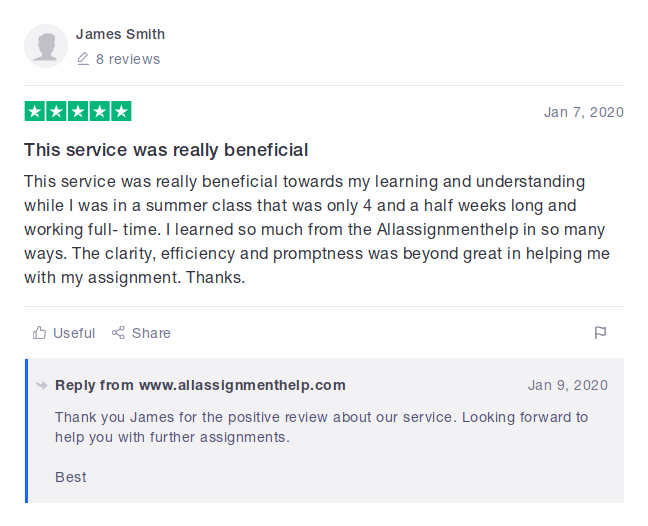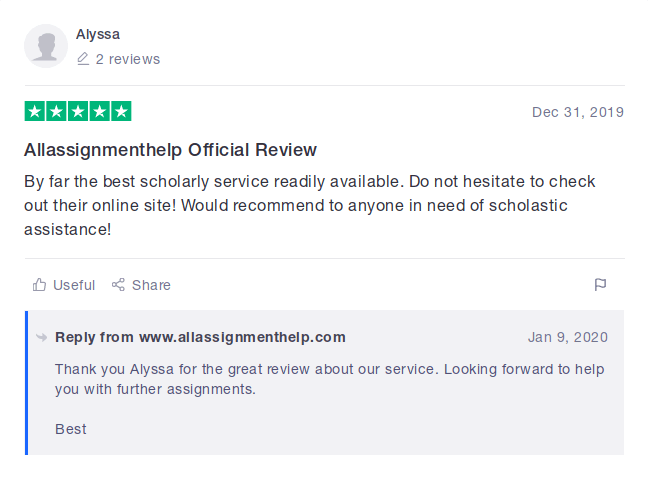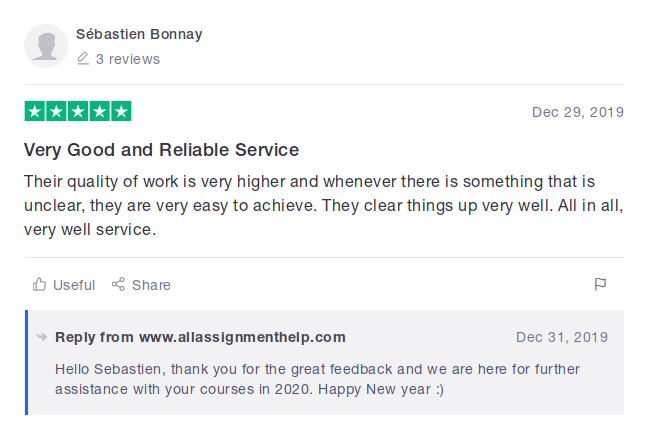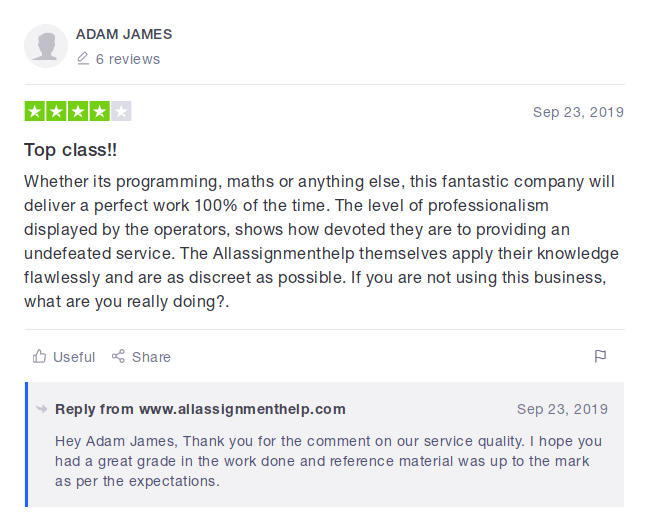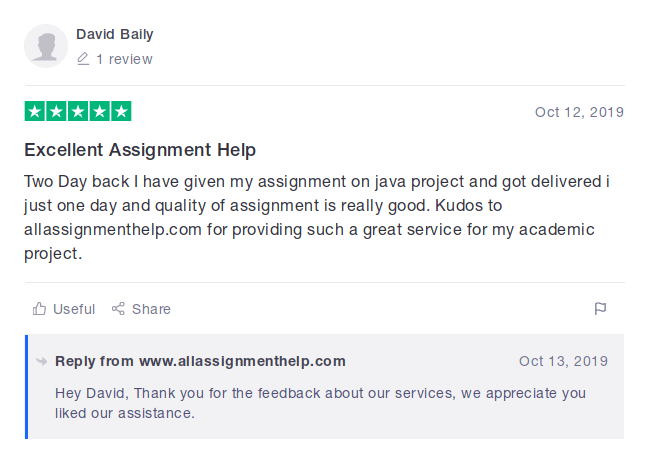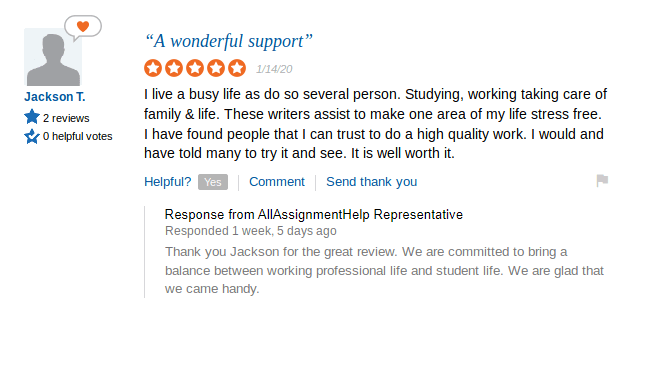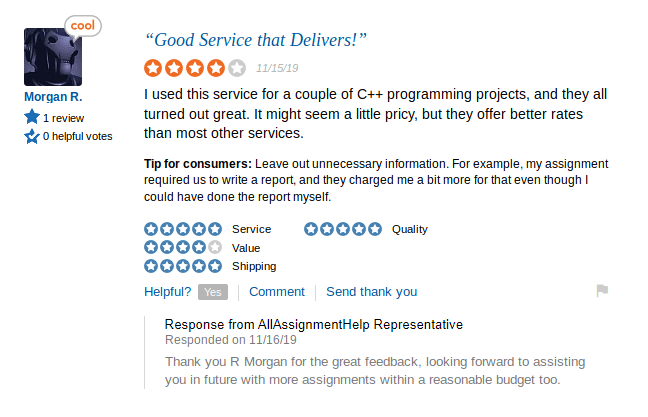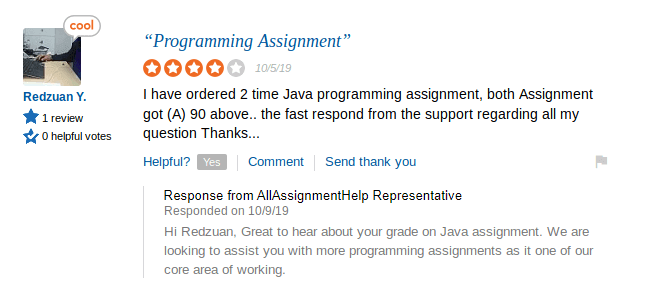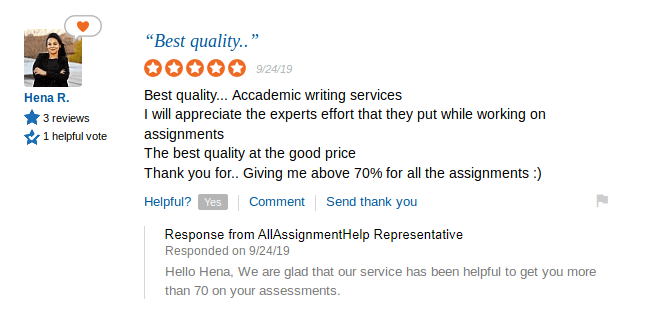Why students order last minute assistance with assignments from us
You have the flexibility to chose an assignment expert that suits your budget and quality parameters. We have more than 2000 PhD experts available to assist with assignments.
-
Order Preview Before Final Work
You get a preview before making final payment.
-
Pay Using different channels
You can pay using multiple secure channels, such as PayPal or Credit Cards.
-
Plagiarism Free Work Guaranteed
We sent unique content with no plagiarism.
-
Ping Us On Live Chat
You can talk to us anytime around the clock. We are up for the support.
-
Choose Your Own Expert
We let you chose from the pool of 2000 PhDs tutors.
-
Go Mobile
You do not need to be on laptop all the time, our mobile interface is great to use.
Reviews and Trust Go Hand In Hand
Allassignmenthelp.com has garnered nothing but praise from the clients. Any trustworthy review platform has positive review about our service and gives us motivation to improve.
Claim Your Offer
30% OFF & 150% Cashback on your First order !
Type your whatsapp number to get an exclusive code.
Recent Completed Projects
You can look at some of the samples that we did recently, we strongly recommend not to use samples for writing your assignment.
Now you don't have to wander anymore
Come to us for any type of assignment help, we do it all
Place Your OrderIntroduction
When it comes to power generation in Australia, it is wholly self- sufficient and there is no reliability on outside sources for its generation. In some parts of the country, black coal is dominant and in some brown coal for production of power and in Tasmania, hydroelectric energy provides all the power to it. As we know that Australia is a huge exporter of coal and natural gas and since the fossil fuels are readily available and that too at nominal costs, even now there has been no clear clarification as to why the nuclear power has been introduced. Australia has uranium in huge quantity since long and has been exporting the same to Asia and Europe.
Past and current power generation in Australia
The supply of power in Australia is managed by two major organizations. The very first organization which was established was Electricity supply association of Australia. This organization was founded in the year 1918 and it was consisted of State regulatory authorities and comprised of generation, transmission and distribution bodies. This association continued till the year 1991 and later the arrangements were made again and the association was re-organized to respond to better opportunities. This was considered to be a major step (Blakers, Lu, & Stocks, 2017). The image below shows how the transportation of electricity takes place.
Now the whole association comprises of both the private and public entities. The whole scenario has been changed. After 1991, the era clicked wherein new independent companies came up in front to invest in this field. The association comprises of members from outs of the country which are New Zealand, South Pacific etc. These members together deal with the issues related to procurement and management.
One of the other major contribution in this sector has been made by the Australian National Committee. The idea of this was popped up by Mr. EL Merigan, who was the head of the State Electricity Commission of Victoria and who later became Commissioner of Snowy mountains hydroelectric authority. It was established in 1950s and was sponsored by Electricity supply association of Australia.
Mentioned below are the sources of power generation in Australia:
- Coal composes of 73%
- Natural gas consists of 13%
- Hydro-power consists of 7%
- Wind composes of 4%
- Rooftop solar consists of 2%
- Bio-energy consist of 1%
"I was in the mid of my academic year, and there was a lot of assignments pending. I thought it was impossible to do them in the limited time. However, my friend cured me. She told me about the assignment helpservice of AllAssignmentHelp.com in Australia. I contacted them and got all my work prior the date of submission. I am too happy that I trusted them."
Oliver Jones,
Melbourne
Distribution structures in Australia
The distribution structure of the Australian power market is under close scrutiny as the prices of electricity has been shot up leading to problems for common people. The prices increased from 2010-2016 due to which the demand went down at many levels. This change in market scenario did not put the retailers to any loss because they were getting their share of the whole of it including generation, transmission and distribution. In the year 1990, the Government of the country created division between two departments called generation and retail of the power. Efforts have been made to manage the risk and curtain them down by integration of generators and retailers (McKenry, MacDonald, & Law, 2017).
The market is regulated as well as unregulated, which gives liberty to consumers to choose their power provider. The Nominal amount of margin is allowed to be made by the retailers ranging from 4 to 10 percent. On the other hand, the retailers are also free to choose their power providers and it can be taken from any State, except the State of Victoria because they only deal in standardized contracts. The demand for these resources are expected to increase in the future, however, the pace with which these are going to increase will be slow.
If we look at the statistics, in Australia, the household bill from the year 2005 to 2015 increased to 85% and it covers all the three costs which are transmission, distribution and retail costs. There are numerous expenses which are involved when it comes to increase in prices, which are replacing the obsolete assets, costs involved in the expansion of the network, developing high reliable standards of networks, etc.
It is to be noticed that in a region like Australia, where the population is less and the power services are high, the services can be very efficiently reached at the footstep of customers and there is possibility of survival of monopoly of suppliers (Deloitte, 2015). Government plays an important role here and it is important for the Government of the country to put regulation on customers for benefits of customers in the long run as well as to provide benefits to the owners. The important factor which is to be considered in this sector is proper maintenance of the networks and assets. The regulation of the market should be proper because any over-investment or losses may prove disadvantageous for the customers as the prices will have to be increased. In the year 2015, the investigation was done with regard to high prices of power on a reference by the senate. The reasons which came up in front which led to higher prices are first that the investments made in the past were not sufficient for survival of the system in the long run and the other reason is poor regulatory methods.
Advancement in technology
The technology is improving at a faster pace and more and more people are getting aware of it. The use of better increases productivity and decreases the overall cost proving to be advantageous for the end consumers. This advancement may lead to saving of power by the people themselves and they can store it. People are moving quickly towards this self-sufficiency and once they are self-sufficient with regard to power, the networks which are already exiting may go into losses and will not be utilized. So it has become imperative for the stakeholders to provide better services to customers and make a unique selling proposition if they really want to survive in the market. A national approach needs to be adopted by the market players by developing policies that can reach the core of the market and end consumers (Stewart, 2017).
Wholesale prices in this market are to be determined after a few minutes because the market is ever changing. Energy markets are considered to be the most volatile market and prices are to be changed keeping in mind the fluctuations in demand. The retailers buy the power in chunks and sell in lesser amounts to customers as per the needs. There is a difference between the pricing policies when it comes to retailers and consumers. There are numerous expenses which are involved when it comes to increase in prices, which are replacing the obsolete assets, costs involved in the expansion of the network, developing high reliable standards of networks, etc. The prices which the retailers pay to wholesalers are highly volatile, on the other hand the prices which customers pay are fixed.
Procurement Practices
The National Electricity Market is comprised of five regions in relation to power trade activities which are New South Wales, South Australia, Victoria, Queensland and Tasmania. These all the areas are linked with each other through transmission programs which are very superior in voltage. These are basically established to keep a check on the prices in all the regions and there should be a similarity of prices in all the regions. When the lines are not working properly and are hampered due to any reason, the prices may start varying (CIGRE & AHEF, 1996).
The Australian Energy Market Operator controls all the trading in the NEM and these are regulated keeping in mind the National Rules in relation to electricity. The important components of this market include:
- Demand for power should be similar to the supply from the generators. There should not be fluctuations of price frequently otherwise the consumers will suffer to a great extent.
- Six dispatch prices are averaged every half hour, which interprets the main price after an interval of every hour for all the regions in the country.
- The National Electricity Rules provide for a main price of $12,000 per MWh which is the upper mark and the price cannot be increased more than this and the lowest price is $1,000 per MWh and it cannot be decreased than this. This negative market floor price permits generators to give to keep online when the price of keeping online is lesser than the price of closing down and initiating the power machinery again. For a renewable generator, keeping online may also cost less than what generators get from support mechanisms.
- Collateral markets are utilized by the associations to regulate the power system in a very secure manner. These services set up the important technical features of the system, including standards for frequency, voltage, network loading and system restart processes and allow supply and demand to be regularly balanced within a five-minute dispatch intervals (Ball, et al., 2016).
The market operators working in the Australian market are The Australian Energy Market Operator (AEMO), The Independent Market Operator (IMO) and The Retail Energy Market Company Ltd (REMCo). Apart from these there are state regulatory bodies and licensed electricity and gas retailers. These are listed in the table below:
Place Order For A Top Grade Assignment Now
We have some amazing discount offers running for the students
Place Your Order| State | Regulatory body | List of licensed energy retailers |
|---|---|---|
| Queensland | Queensland Competition Authority (QCA) | Queensland energy retailers |
| New South Wales | Independent Pricing and Regulatory Tribunal (IPART) | Queensland energy retailers |
| Australian Capital Territory | Independent Competition and Regulatory Commission (ICRC) | ACT energy retailers |
| Victoria | Essential Services Commission (ESC) of Victoria | Licences of the ESC |
| Tasmania | Office of the Tasmanian Economic Regulator (OTER) | Tasmanian electricity retailers, Tasmanian gas retailers |
| South Australia | Essential Services Commission of South Australia (ESCoSA) | South Australian electricity retailers South Australian gas retailers |
| Western Australia | Economic Regulation Authority (ERA) | Western Australian electricity retailers Western Australian gas retailers |
| Northern Territory | Utilities Commission | Utilities Commission |
The energy procurement in Australia by the retailers is done by tendering, negotiations or with the help of intermediaries carrying out the negotiations. Tendering is proposals are given by understanding the energy requirements and these proposals are assessed by the suppliers and the best proposal among these is then accepted. The proposals by all the retailers are compared and assessed carefully and the supplier may sometimes even ask for certain changes to be made to these. The second way for procurement of power which is followed by the retailers is negotiation. In this, the retailer decides a cost per unit power which is reasonable and liked to the current market price. The rounds of negotiation them take place and the deal is done once the decided selling price is suitable to both the retailer and the supplier. The third method of procurement is a varied form of negotiation where in the intermediaries negotiate on behalf of the retailers. These intermediaries are experts in this field and offer their services by developing negotiation and procurement strategies, assessing the ongoing strategies and giving advice on the potential risks involved and the possible opportunities. They assess the peer proposals and the market trends to take the decisions that work in favour of the retailer or the organization which has hired them. The intermediaries also audit the needs and requirements and ensure efficiency and response from the supply and demand side.
Amcor, for example, follows tendering to procure energy. They follow a centralized procurement process where they maintain a relationship with a single user in each of the Australian states. They follow a strategy of entering short term contracts by offering tenders when the market is bearish and the prices go up and in a bearish market, they contract for a longer term as it is beneficial for the organization. Oxford Cold storage is another end user of power for their operations. They make use of an intermediary for the procurement process. The role of the intermediary in this case is to undertake tenders periodically on behalf of the Oxford Cold Storage, assess offers made by their competitors and ensure smooth flow of the procurement process. The intermediary charges an annual fee for this and the organization receives the benefits all year long without getting into the hassles of contracting and following up.
At present in Australia, not only the older plants are being replaced, but older technology should also be replaced. These two have major implications and are adding to the overall cost of generation of power making it difficult for common people to buy power. The everyday work of people and industries are based on power and this sector has been growing at a phenomenal speed. The dependency is high on the resources and he conditions are controlled with the help of technology and success rate is totally high. Although the initial investment cost is high and the maintenance cost is also high, but the return on investment is also high. An important point which is to be noticed here that it is very difficult for new entrants to enter this field until and unless an already existing user steps out from the market. There is no window for new entrants and only once an operator shuts down his system, the other one can enter the market.
Note: This is not a complete solution. You can request the complete solution by filling out the order form towards your requested assignment.
Place Order For A Top Grade Assignment Now
We have some amazing discount offers running for the students
Place Your OrderREFERENCES
Australian Government. (2017). Hydro Energy: Australia's hydro energy resources. (Commonwealth of Australia) Retrieved from https://www.ga.gov.au/: https://www.ga.gov.au/scientific-topics/energy/resources/other-renewable-energy-resources/hydro-energy
Australian Government. (2017). Australian Energy Statistics. Retrieved from https://industry.gov.au/Office-of-the-Chief-Economist/Publications/Pages/Australian-energy-statistics.aspx
Ball, A., Ahmad, S., McCluskey, C., Pham, P., Dawson, L., Nguyen, T., & Nowakowski, D. (2016). Australian Energy Update. Retrieved from https://www.industry.gov.au/Office-of-the-Chief-Economist/Publications/Documents/aes/2016-australian-energy-statistics.pdf
Bank, T. W. (2014). Electric power consumption (kWh per capita). Retrieved from https://data.worldbank.org: https://data.worldbank.org/indicator/EG.USE.ELEC.KH.PC
Blakers, A., Lu, B., & Stocks, M. (2017).100% renewable electricity in Australia. Australian National University. Retrieved from https://energy.anu.edu.au/files/100%25%20renewable%20electricity%20in%20Australia.pdf
Bureau of resources and energy economics. (2012). Key facts Australia’s Energy Sector. Retrieved from https://industry.gov.au/Office-of-the-Chief-Economist/Publications/Documents/energy-in-aust/energy-in-australia-fact-card.pdf
Business Council of Australia. (2014). Australia’s Energy Advantages. Retrieved from https://www.google.co.in/url?sa=t&rct=j&q=&esrc=s&source=web&cd=6&cad=rja&uact=8&ved=0ahUKEwjF8prQ1-HVAhUBPY8KHapdBlgQFghDMAU&url=http%3A%2F%2Fwww.bca.com.au%2Fdocs%2F4170466f-8347-4540-ab8f-e2d5e19a79a3%2FAustralias_Energy_Advantages_FINAL_10.11.2014.pdf
CIGRE, & AHEF. (1996). A dictionary of electricity. Retrieved from https://www.ewh.ieee.org/r10/nsw/subpages/history/electricity_in_australia.pdf
Deloitte. (2015). Economic benefits of better procurement practices. Consult Australia. Retrieved from https://www.consultaustralia.com.au/docs/default-source/infrastructure/better-procurement/dae---consult-australia-final-report-050215---96-pages.pdf
Department of Industry and Science. (2015). Australian Energy Update. Retrieved from https://industry.gov.au/Office-of-the-Chief-Economist/Publications/Documents/aes/2015-australian-energy-statistics.pdf
Energy, A. G. (2017). The energy supply chain. Retrieved from https://www.eex.gov.au/large-energy-users/energy-management/energy-procurement/energy-pricing/the-energy-supply-chain
 +1-817-968-5551
+1-817-968-5551 +61-488-839-671
+61-488-839-671 +44-7480-542904
+44-7480-542904
